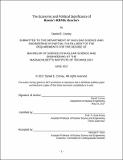| dc.contributor.advisor | R. Scott Kemp. | en_US |
| dc.contributor.author | Corney, Daniel E | en_US |
| dc.contributor.other | Massachusetts Institute of Technology. Department of Nuclear Science and Engineering. | en_US |
| dc.coverage.spatial | e-ru--- | en_US |
| dc.date.accessioned | 2017-12-05T16:25:03Z | |
| dc.date.available | 2017-12-05T16:25:03Z | |
| dc.date.copyright | 2017 | en_US |
| dc.date.issued | 2017 | en_US |
| dc.identifier.uri | http://hdl.handle.net/1721.1/112373 | |
| dc.description | Thesis: S.B., Massachusetts Institute of Technology, Department of Nuclear Science and Engineering, 2017. | en_US |
| dc.description | This electronic version was submitted by the student author. The certified thesis is available in the Institute Archives and Special Collections. | en_US |
| dc.description | Cataloged from student-submitted PDF version of thesis. | en_US |
| dc.description | Includes bibliographical references (pages 38-40). | en_US |
| dc.description.abstract | The safety of continued operations of Russian Raktor Bolshoy Moshchnosti Kanalnyy (RBMK) reactors is often questioned. The original RBMK design was riddled with deficiencies in its shutdown procedures resulting in unsafe operation under certain conditions, most notably resulting in the April 26th Chernobyl disaster. Despite implementing modifications to correct these problems, almost all countries permanently cancelled existing RBMK reactor operations. The sole exception to the European decommissioning effort was Russia. In Russia, RBMKs make up approximately 35% of the country's nuclear power, and are a significant source of heat energy and electricity for specific high priority and remote regions. As a result, Russia relies on the RBMK reactors as an important component within a weakened industrial infrastructure. By analyzing the safety concerns of the RBMK reactors in conjunction with the reactors' economic and political contributions to the country, a conclusion as to whether or not Russia should continue operating the reactors or transition to an alternative technology should be discoverable. Subsequent discussion should address the modern safety and operating issues of RBMKs along with the generic risks of operating nuclear power plants to determine whether the reactors' are capable of operating safely. Furthermore, this research should help consolidate existing, yet scattered data, pertaining to the significance of RBMKs to create a concise evaluation of their continued operation. | en_US |
| dc.description.statementofresponsibility | by Daniel E. Corney. | en_US |
| dc.format.extent | 40 pages | en_US |
| dc.language.iso | eng | en_US |
| dc.publisher | Massachusetts Institute of Technology | en_US |
| dc.rights | MIT theses are protected by copyright. They may be viewed, downloaded, or printed from this source but further reproduction or distribution in any format is prohibited without written permission. | en_US |
| dc.rights.uri | http://dspace.mit.edu/handle/1721.1/7582 | en_US |
| dc.subject | Nuclear Science and Engineering. | en_US |
| dc.title | The economic and political significance of Russia's RBMK reactors | en_US |
| dc.title.alternative | Economic and political significance of Russia's Raktor Bolshoy Moshchnosti Kanalnyy reactors | en_US |
| dc.type | Thesis | en_US |
| dc.description.degree | S.B. | en_US |
| dc.contributor.department | Massachusetts Institute of Technology. Department of Nuclear Science and Engineering | |
| dc.identifier.oclc | 1011356539 | en_US |
